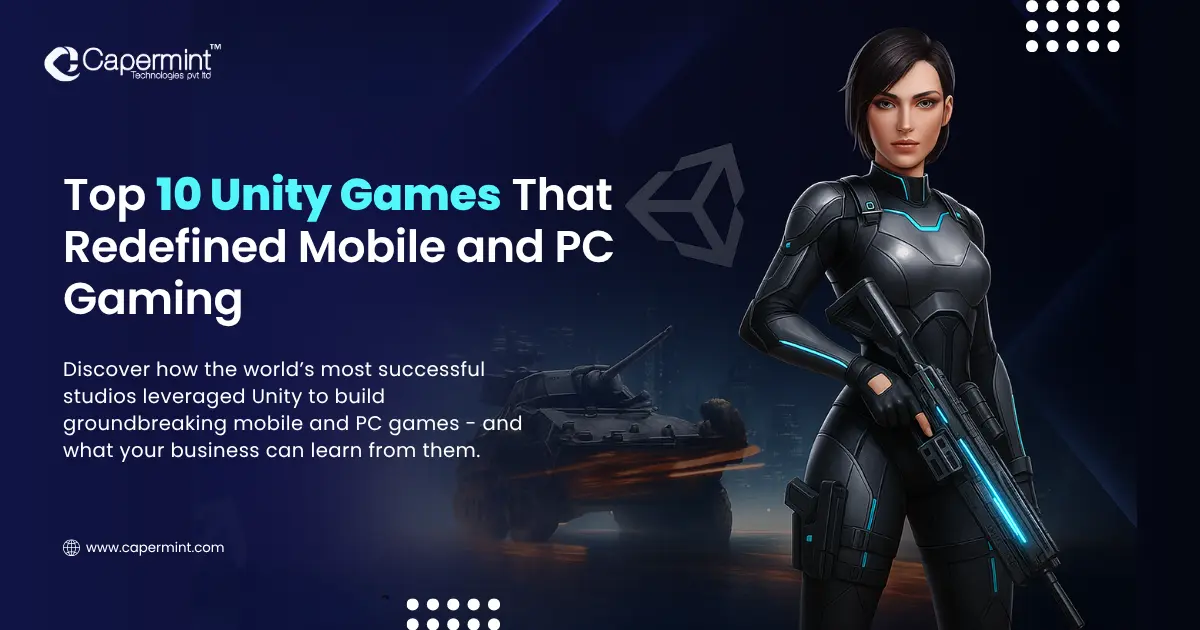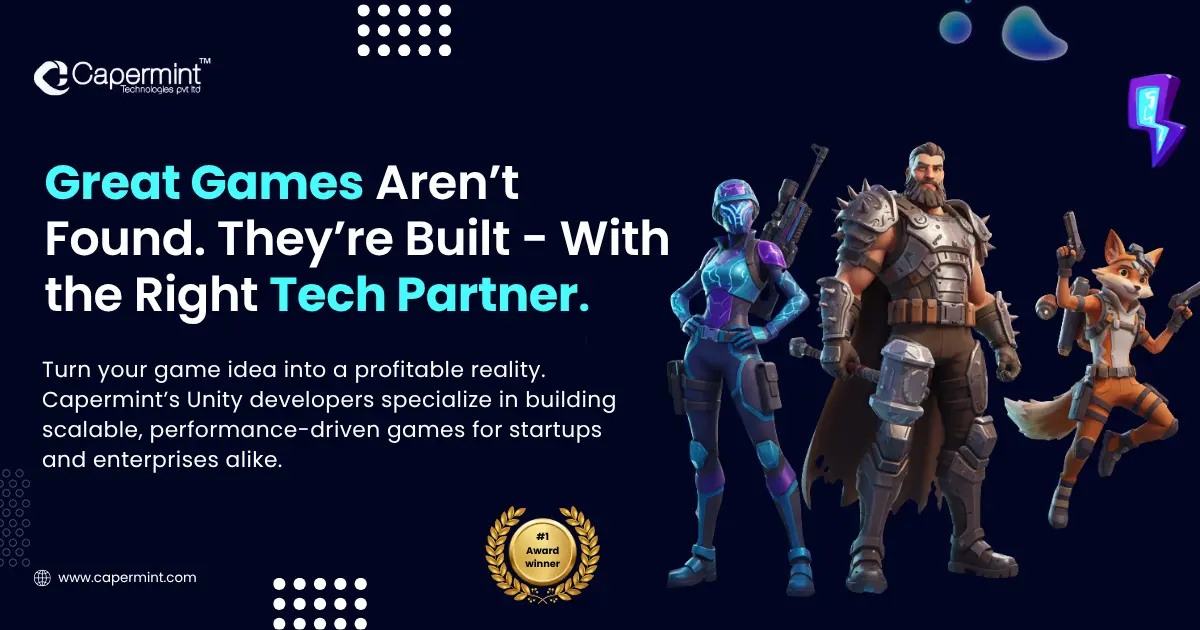Introduction
Unity has revolutionized the gaming industry, establishing itself as the most versatile game development engine in 2025. Powering approximately 70% of mobile games, Unity’s influence extends from indie projects to AAA ecosystems, demonstrating remarkable scalability and adaptability across every gaming platform.
Unity’s relevance in 2025 continues to grow as it adapts to emerging technologies. From mobile devices to high-end gaming PCs, VR headsets to AR experiences, Unity developers have with tools to create immersive experiences across all platforms. This cross-platform capability ensures Unity remains at the forefront of game development technology.

What Makes Unity Popular for Game Developers
Cross-Platform Support: Build Once, Deploy Everywhere
Unity’s exceptional cross-platform support allows developers to write code once and deploy across iOS, Android, Windows, Mac, Linux, consoles, and web platforms with minimal adjustments. This dramatically reduces game development costs and time, enabling studios to reach the largest possible audiences without maintaining separate codebases.
The Unity mobile games ecosystem particularly benefits from this approach. Developers can prototype on PC, test on mobile devices, and deploy to app stores seamlessly, allowing indie developers to compete with larger studios.
Asset Store Ecosystem: Accelerating Development
The Unity Asset Store provides thousands of ready-made assets, tools, scripts, and complete project templates. This ecosystem enables developers to significantly accelerate development timelines while fostering a vibrant community where developers share knowledge and solutions.
Affordable Licensing and Community Support
Unity’s free Personal license provides full engine functionality for individuals and small studios, while paid tiers scale with business needs. This democratizes game development, enabling creators to bring visions to life regardless of budget. The millions-strong Unity community provides invaluable support through forums, tutorials, and documentation.
Real-Time Rendering Capabilities
Unity excels at real-time rendering across 2D, 3D, VR, and AR projects. The engine supports stunning visual effects from realistic lighting to complex particle systems. Whether creating stylized 2D platformers or photorealistic 3D environments, Unity provides the necessary tools and performance across different target platforms.

Top 10 Games Developed with Unity Game Platform
1. Genshin Impact: Open-World Gaming Revolution
Genshin Impact stands as the most impressive demonstration of Unity’s capabilities for Unity mobile games. This free-to-play action RPG features a massive open world, stunning anime-inspired graphics, and complex combat systems rivaling console games. The game’s multi-billion dollar success proves Unity can power commercially successful AAA titles, setting new standards for mobile gaming achievements.
2. Call of Duty: Mobile: AAA Franchise Goes Mobile
Activision’s choice of Unity for Call of Duty: Mobile demonstrated the engine’s credibility for major franchises. The game delivers fast-paced multiplayer action with graphics honoring the franchise’s legacy, handling complex networking for 100-player battle royale modes. This represents one of the most successful Unity game examples of adapting established franchises for mobile audiences.
3. Cuphead: Artistic Excellence and Technical Achievement
Cuphead showcases Unity’s flexibility for unique artistic visions with hand-drawn animation inspired by 1930s cartoons. The game’s success across PC, consoles, and mobile demonstrates Unity’s ability to preserve artistic integrity across platforms, proving indie games on Unity can achieve both critical acclaim and commercial success.
4. Among Us: Social Gaming Phenomenon
This social deduction game built by a tiny team became a global phenomenon with hundreds of millions of players. Among Us demonstrates Unity’s strength in networking and cross-platform play, with players on mobile, PC, and consoles playing together seamlessly. The game proves compelling gameplay trumps graphics fidelity.
5. Pokémon GO: Augmented Reality Pioneer
Niantic’s Pokémon GO revolutionized mobile gaming by bringing AR to mainstream audiences. Using Unity’s AR capabilities, the game overlays Pokémon onto real-world environments, remaining one of the most successful mobile games ever. It opened floodgates for VR games Unity and AR experiences expanding the gaming landscape.
6. Monument Valley 2: Puzzle Perfection
Monument Valley 2 exemplifies how Unity enables artistic expression with impossible geometry, minimalist aesthetics, and thoughtful level design creating emotional resonance. The developers leveraged Unity’s lighting system and shader capabilities to create distinctive visuals, demonstrating Unity supports both technical achievement and creative vision.
7. Hollow Knight: Metroidvania Masterpiece
Hollow Knight showcases Unity’s power for 2D game development with hand-drawn art, precise combat, and sprawling interconnected world design. The game’s success across multiple platforms proves Unity’s versatility, with Team Cherry creating a game delivering dozens of hours of content with flawless performance.
8. Escape from Tarkov Arena: Hardcore Tactical Combat
Battlestate Games’ Escape from Tarkov showcases Unity’s capabilities for hardcore, realistic shooters with complex ballistics systems, detailed weapon customization, and intense tactical gameplay. The game demonstrates Unity can handle simulation-heavy gameplay with numerous interacting systems, supporting niche, hardcore experiences effectively.
9. Ori and the Blind Forest: Platforming Poetry
Moon Studios created one of the most beautiful platformers ever made, combining challenging gameplay with stunning hand-painted visuals. Ori’s fluid animation, dynamic lighting, and atmospheric effects demonstrate Unity’s rendering prowess, showing how small teams can create experiences rivaling major studio releases.
10. Hearthstone: Digital Card Game Giant
Blizzard Entertainment chose Unity for Hearthstone, which became one of the most successful digital collectible card games. The game’s polished presentation, smooth animations, and cross-platform functionality showcase Unity’s strengths for online multiplayer games with complex backend systems, proving Unity handles flagship titles from industry-leading developers.
What Developers Can Learn from These Games
Performance Optimization: Making Games Run Smoothly
The best games made with Unity share excellent performance optimization. Genshin Impact runs on modest mobile hardware through aggressive LOD systems, efficient asset streaming, and careful memory management. Key lessons include object pooling, optimizing draw calls through batching, and implementing efficient asset loading strategies.
Monetization Strategies: Building Sustainable Games
Successful titles demonstrate diverse monetization approaches. Genshin Impact’s gacha system generates billions through in-app purchases while remaining free-to-play. Hollow Knight proves premium pricing works for quality experiences. Unity engine success stories reveal monetization works best when enhancing rather than detracting from player experience.
Visual Design: Creating Memorable Aesthetics
Each featured game possesses distinctive visual identity. Rather than pursuing photorealism, successful developers often choose stylized aesthetics that age gracefully and run efficiently across platforms. Unity’s shader system, lighting tools, and post-processing effects enable unique visual styles that prioritize artistic consistency over raw graphical power.
Scalability: Growing with Your Game
Games like Hearthstone and Pokémon GO demonstrate Unity’s suitability for live-service models requiring constant updates. Unity’s architecture supports modular development, allowing teams to add content without disrupting existing systems. Planning for scalability from day one helps games grow successfully with longevity.
Capermint’s Expertise with Unity Game Development
Comprehensive 2D and 3D Development
Capermint brings extensive experience across Unity’s full spectrum of capabilities. Our team excels in both 2D and 3D game modeling and development, creating everything from casual mobile puzzlers to complex 3D multiplayer experiences. We understand Unity’s tools, best practices, and optimization techniques separating adequate games from exceptional ones.
Multiplayer and AR/VR Specialization
Capermint specializes in Unity’s networking solutions, creating stable multiplayer games handling everything from turn-based interactions to real-time competitive action. Our experience with Unity’s AR and VR frameworks positions us to create innovative experiences leveraging these growing platforms, ensuring projects leverage cutting-edge capabilities.
Full-Cycle Development Support
From initial concept through post-launch support, Capermint provides comprehensive game development services. We handle pre-production planning, core development, quality assurance, optimization, launch support, and ongoing maintenance. This full-cycle approach ensures consistent quality throughout your game’s lifecycle.
Conclusion
Unity has proven itself as the premier game development engine for mobile and PC platforms. The best games made with Unity span every genre, art style, and business model, demonstrating remarkable versatility. From Genshin Impact’s open-world grandeur to Among Us’s minimalist social gameplay, Unity empowers developers to realize any creative vision.
Looking at the Unity game list 2025, it’s clear the engine’s influence will only grow. As Unity continues evolving with new rendering pipelines and expanded platform support, the next generation of groundbreaking games will likely bear the Unity logo. These success stories provide roadmaps for aspiring developers, demonstrating that with Unity, technical limitations need not constrain creative ambitions.
Ready to Build Your Unity Game?
Whether you’re inspired to create the next Genshin Impact or have a unique vision requiring Unity’s capabilities, professional development support can transform your concept into reality. Capermint’s Unity game development expertise covers every aspect of creating exceptional gaming experiences, applying insights from the industry’s most successful Unity games.
Contact Capermint today to discuss how our Unity development services can bring your gaming vision to life. Let’s create the next Unity 3D showcase title that players will remember for years to come.
Frequently Asked Questions (FAQs)
1. What percentage of mobile games use Unity?
Approximately 70% of mobile games are powered by Unity, making it the dominant game development engine in the mobile gaming industry. This widespread adoption stems from Unity’s cross-platform capabilities, affordable licensing, and robust feature set that supports everything from simple 2D games to complex 3D experiences.
2. Why do developers choose Unity over other game engines?
Developers choose Unity for its cross-platform deployment, extensive Asset Store ecosystem, affordable licensing model, strong community support, and versatility across 2D, 3D, AR, and VR development. Unity enables building games once and deploying across multiple platforms with minimal modifications, significantly reducing development time and costs.
3. Can Unity handle AAA game development?
Yes, Unity can handle AAA game development, as demonstrated by successful titles like Genshin Impact, Call of Duty: Mobile, and Hearthstone. These games showcase Unity’s ability to deliver high-quality graphics, complex gameplay systems, and large-scale multiplayer functionality comparable to games built with other industry-standard engines.
4. Is Unity good for indie game development?
Unity is excellent for indie game development due to its free Personal license, accessible learning curve, extensive documentation, and supportive community. Many successful indie games like Hollow Knight, Cuphead, and Among Us were built with Unity by small teams, proving the engine empowers independent developers to create commercially successful titles.
5. Can Unity be used for VR and AR games?
Yes, Unity provides robust support for both VR and AR game development. Pokémon GO is a prime example of Unity’s AR capabilities, while numerous VR games across platforms like Oculus, PlayStation VR, and HTC Vive use Unity. The engine includes dedicated frameworks and tools optimized for immersive experiences.
6. How much does Unity cost for game development?
Unity offers a free Personal license for individuals and small studios earning less than $200,000 annually. Paid tiers include Unity Plus ($399/year), Unity Pro ($2,040/year), and Unity Enterprise (custom pricing). The free version includes full engine functionality, making professional game development accessible to developers with limited budgets.
7. What programming language does Unity use?
Unity primarily uses C# (C-Sharp) for scripting, which is relatively accessible for developers with programming experience. The engine also supports visual scripting tools for designers and non-programmers. Unity’s use of C# provides a good balance between performance, ease of learning, and powerful programming capabilities.



